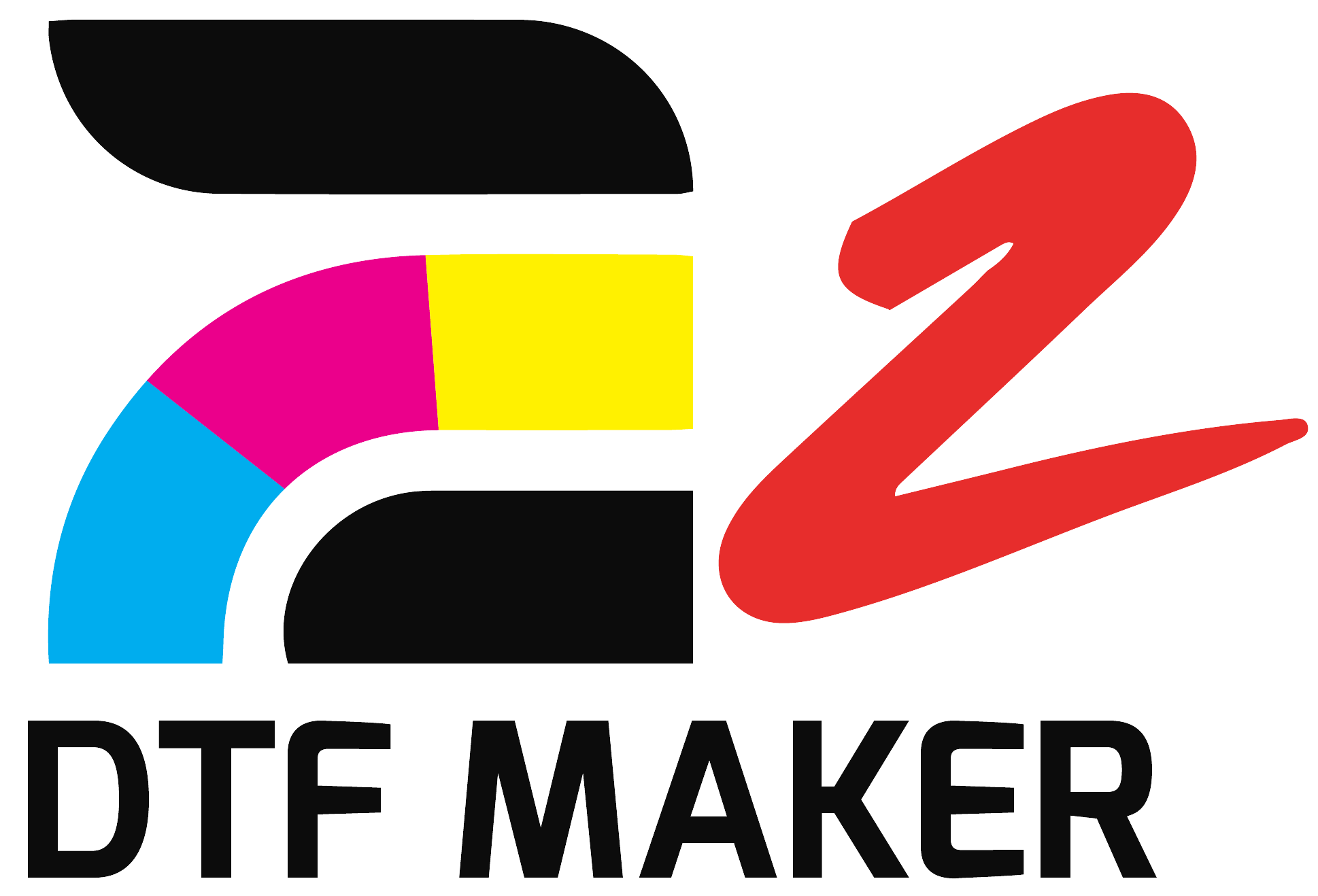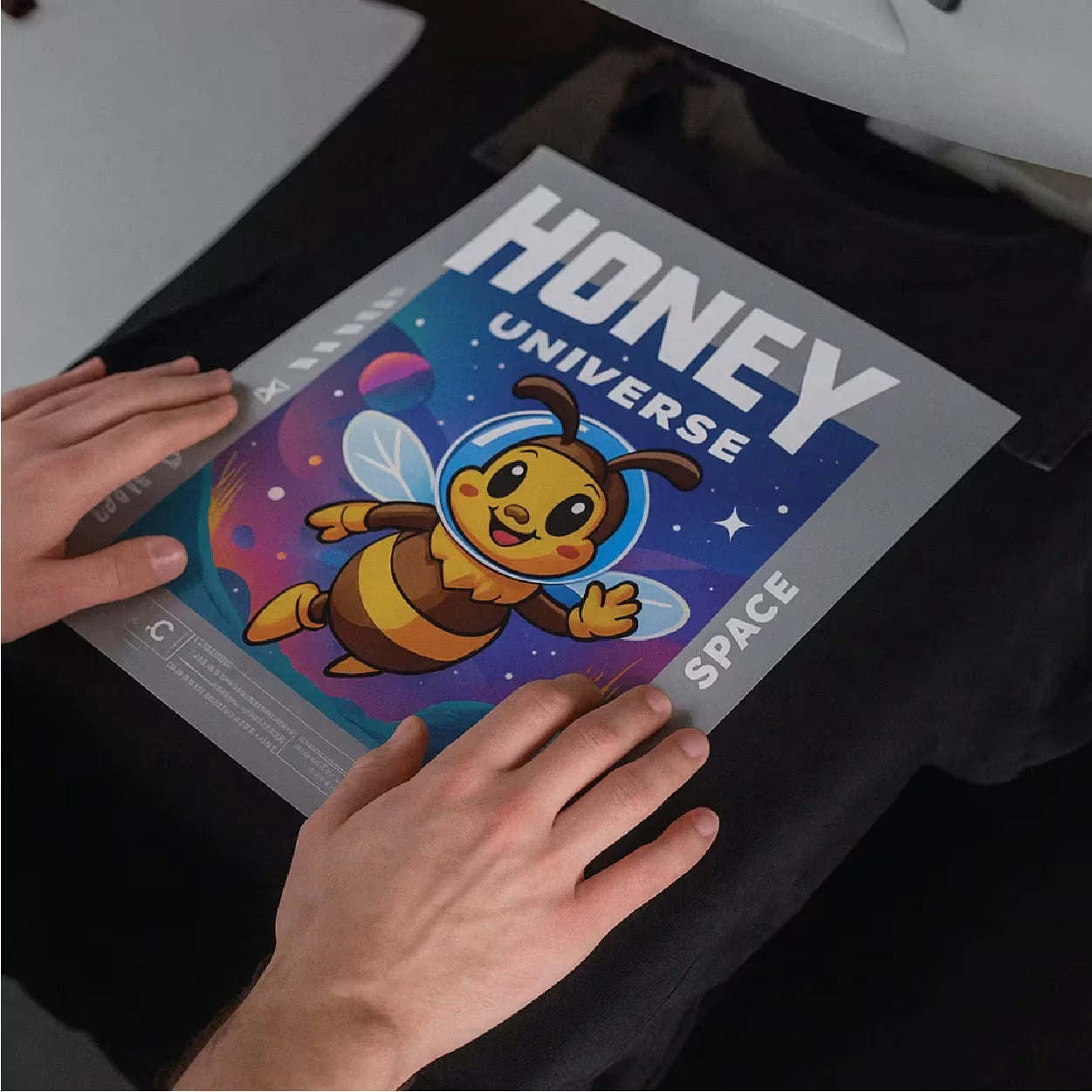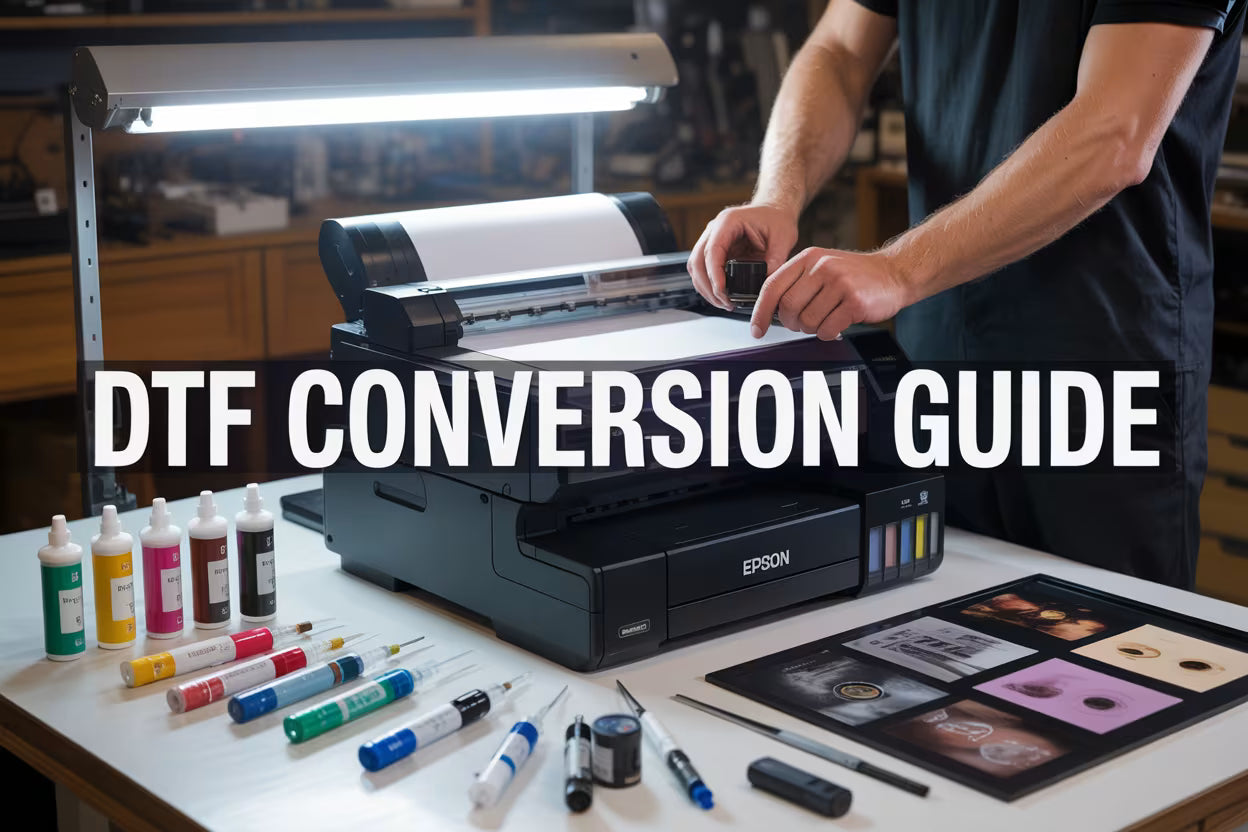Introduction
DTF printing has revolutionized the custom apparel industry, offering businesses and creators an efficient way to produce high-quality prints on various garments.
Whether you're running a small business or managing large-scale production, mastering DTF transfer application is your key to success. This comprehensive guide covers everything from equipment selection to troubleshooting common issues.
Why DTF Transfers Are Game-Changers
- Vibrant colors on any fabric type
- No minimum order requirements
- Exceptional durability with proper application
- Cost-effective for small and large runs
Ready to get started? Check out our premium DTF transfer collection for professional-grade designs.
Essential Equipment and Setup
Heat Press Selection: Your Foundation for Success
Choosing the right equipment is crucial for achieving best results with DTF transfers. Here's what you need:
Commercial-Grade Heat Press Features:
- Precise temperature controls (±5°F accuracy)
- Even heat distribution across the entire platen
- Consistent pressure settings
- Digital timer for accurate timing
For Beginners:
While a household iron can work initially, investing in a proper heat press will dramatically improve your results and efficiency.
💡 Pro Tip: Look for suppliers offering free shipping in the United States to reduce startup costs.
Essential Accessories Checklist
| Item | Purpose | Why It Matters |
|---|---|---|
| Teflon/Protective Sheet | Prevents direct contact | Ensures even heat, protects design |
| Lint Roller | Surface preparation | Removes debris that affects adhesion |
| Digital Thermometer | Temperature verification | Maintains consistency across batches |
| Test Fabric Scraps | Settings verification | Prevents costly mistakes |
Step-by-Step DTF Transfer Application
Phase 1: Pre-Application Preparation
Success starts before you even touch the heat press.
Garment Preparation (2-3 minutes per piece):
- Identify fabric type - This determines your temperature settings
- Use lint roller to remove all surface debris
- Check for wrinkles and iron flat if needed
- Inspect for defects that could affect adhesion
Workspace Organization:
- Position all materials within arm's reach
- Ensure adequate ventilation
- Keep scrap fabric nearby for testing
- Have cleaning supplies accessible

Looking for high-quality blanks? Our garment recommendations guide shows the best fabrics for DTF transfers.
Phase 2: Temperature and Pressure Settings
Temperature Guidelines by Fabric Type:
| Fabric Type | Temperature | Pressure | Special Notes |
|---|---|---|---|
| 100% Cotton | 300-320°F | Medium | Most forgiving for beginners |
| Polyester | 285-300°F | Light-Medium | Sensitive to high heat |
| Cotton/Poly Blends | 295-310°F | Medium | Adjust based on blend ratio |
| Specialty Fabrics | 285-295°F | Light | Test first on scrap material |
Critical Success Factors:
- Regular calibration - Heat presses drift over time
- Even pressure distribution - Prevents partial adhesion
- Temperature verification - Use infrared guns for accuracy

Want to avoid guesswork? Try our DTF sample pack to test different designs on your equipment.
Phase 3: The Pressing Process
Initial Press (10-15 seconds):
- Position transfer carefully on garment
- Apply consistent pressure across entire design
- Start timer immediately when press closes
- Monitor for any shifting during press

Hot Peel vs. Cold Peel:
- Hot Peel: Remove carrier film immediately (most common)
- Cold Peel: Allow to cool before removal (specialty transfers)
The Game-Changing Second Press (5-10 seconds):
This step separates amateur from professional results:
- Embeds design deeper into fabric fibers
- Dramatically improves wash resistance
- Creates smoother, more professional finish

Advanced Techniques and Troubleshooting
Working with Challenging Fabrics
Cotton Fabrics:
Most forgiving for beginners
Wide temperature range acceptable
Strong adhesion with proper technique
Polyester and Synthetics:
Temperature-sensitive - can scorch easily
Lower heat settings required
Test patches essential before full production
Specialty Materials:
Moisture-wicking fabrics: Reduce temperature by 10-15°F
Fleece: Use protective sheet, lower pressure
Textured surfaces: Increase press time slightly
Common Issues and Quick Fixes
| Problem | Likely Cause | Solution |
|---|---|---|
| Poor Adhesion | Too low temperature/pressure | Increase both gradually |
| Scorching | Excessive heat | Reduce temperature 10-15°F |
| Uneven Coverage | Inconsistent pressure | Check heat press level, clean platens |
| Color Bleeding | Too much heat/time | Lower temperature, reduce press time |
| Peeling After Wash | Insufficient second press | Always do second press for 5-10 seconds |
Quality Control and Consistency
Inspection Checklist (Every Transfer):
Complete adhesion across entire design
Proper color reproduction
No scorching or distortion
Smooth, even finish
Proper alignment
Documentation for Success:
Keep records of successful settings:
Fabric type and brand
Temperature and pressure used
Press times (initial and second)
Transfer type and supplier
Environmental conditions
Pro businesses use our gang sheet service to maximize efficiency and reduce waste.
Care Instructions for Maximum Durability
Washing Guidelines:
Cold water wash (30°C/86°F max)
Inside-out washing to protect print surface
Gentle cycle preferred
Air dry or low heat tumble dry
Maximizing Print Life:
Proper initial application sets the foundation
Avoid harsh chemicals and bleach
Store away from direct sunlight
Don't iron directly on printed area
Expected Durability:
With proper application and care:
50+ washes for premium DTF transfers
Commercial-grade performance when done correctly
Fade-resistant colors for 2+ years
Business Applications and Scaling
Small Business Success Strategy:
Startup Advantages:
Low initial investment vs. screen printing
No minimum orders - perfect for custom work
Quick turnaround times
Diverse design capabilities
Workflow Optimization:
Batch similar fabrics together
Standardize temperature settings by fabric type
Quality check every 10th piece
Document successful combinations
Scaling Production:
Volume Efficiency Tips:
Pre-heat multiple presses for continuous operation
Train multiple operators with standardized procedures
Implement quality control checkpoints
Maintain equipment schedules
Inventory Management:
Stock popular transfer sizes
Maintain fabric variety
Track usage patterns
Build supplier relationships
Ready to scale up? Explore our wholesale DTF options for volume pricing.
Equipment Maintenance and Longevity
Daily Maintenance (5 minutes):
- Clean heating platens after each session
- Check temperature accuracy with thermometer
- Inspect pressure consistency
- Clear any adhesive buildup
Weekly Maintenance (15 minutes):
- Deep clean heating surfaces
- Calibrate temperature settings
- Check pressure system components
- Lubricate moving parts as needed
Monthly Maintenance (30 minutes):
- Professional temperature calibration
- Pressure system inspection
- Electrical connection check
- Document maintenance history
Advanced Tips from the Pros
Time-Saving Techniques:
- Batch processing similar items
- Pre-position transfers before heating
- Use multiple protective sheets for quick changes
- Keep detailed setting charts visible
Quality Maximization:
- Test every new fabric type before production
- Maintain consistent room temperature
- Use high-quality transfers for best results
- Never skip the second press
Cost Optimization:
- Buy transfers in bulk for better pricing
- Minimize waste with proper planning
- Track success rates by supplier
- Invest in quality equipment upfront
Conclusion and Next Steps
Mastering DTF transfer application is a journey of continuous improvement and attention to detail. The techniques in this guide provide your foundation, but hands-on experience will refine your expertise.
Your Success Roadmap:
Start with quality transfers and proper equipment
Practice on test materials before customer orders
Document your successful settings
Continuously refine your process
Stay updated on new techniques and materials
Key Takeaways:
Temperature control is critical for success
The second press makes professional difference
Proper preparation prevents most problems
Quality transfers yield quality results
Frequently Asked Questions (FAQ)
Can I use DTF transfers on dark garments?
Yes! DTF transfers work excellently on dark fabrics. Unlike vinyl or sublimation, DTF prints create an opaque layer that shows vibrant colors on any fabric color, including black. No special dark fabric transfers needed.
How many washes before DTF prints start fading?
With proper application and care, premium DTF transfers last 50+ washes before noticeable fading. Key factors:
Correct pressing temperature and time
Cold water washing (inside-out)
Air drying or low heat tumble dry
Quality of original transfer material
What's the difference between DTF and HTV (Heat Transfer Vinyl)?
| Aspect | DTF Transfers | HTV |
|---|---|---|
| Detail Level | High-resolution, photo-quality | Limited to cut designs |
| Colors | Unlimited colors in one design | Each color requires separate layer |
| Fabric Compatibility | Works on all fabrics | Limited fabric options |
| Durability | 50+ washes | 25-40 washes typically |
| Application Time | 15-20 seconds total | 30+ seconds per color layer |
Do I need special equipment for DTF transfers?
You need a heat press (recommended) or household iron as minimum equipment. For professional results:
- Heat press with accurate temperature control
- Protective/Teflon sheets
- Digital thermometer for verification
- Lint roller for garment preparation
Can DTF transfers be applied to polyester athletic wear?
Absolutely! DTF works great on polyester, including moisture-wicking athletic fabrics. Use lower temperature settings (285-300°F) to prevent fabric damage. Always test on scrap material first.
What happens if I use wrong temperature settings?
- Too Low: Poor adhesion, transfer may peel off after washing
- Too High: Fabric scorching, color bleeding, or fabric shrinkage
- Solution: Start with recommended temperatures and adjust in 5°F increments
How long do DTF transfers last in storage?
Properly stored DTF transfers (cool, dry place away from direct sunlight) maintain quality for 12-24 months. Store flat in original packaging for best results.
Can I layer multiple DTF transfers on one garment?
Yes, but allow complete cooling between applications. Apply largest/background design first, then smaller elements. Avoid overlapping areas when possible.
Visual Content Recommendations
For maximum engagement and SEO benefits, consider adding these images:
Essential Images to Include:
Heat Press Setup Diagram
Labeled parts (platen, pressure lever, temperature display)
Proper workspace organization
Safety equipment positioning
Step-by-Step Process Photos
Garment preparation with lint roller
Transfer positioning technique
Proper pressure application
Second press demonstration
Temperature Settings Infographic
Visual chart of fabric types vs. temperature
Color-coded difficulty levels
Quick reference format
Before/After Comparison Images
Common mistakes vs. perfect results
Poor adhesion examples
Professional finish examples
Troubleshooting Visual Guide
Photo examples of common problems
Side-by-side fix demonstrations
Quality control checkpoints
Ready to Get Started?
Transform your apparel business with professional DTF transfers
Explore More with EZT Mart & EZDTF Maker
At EZDTF Maker, we provide everything you need to bring your designs to life — from blank apparel to premium DTF and UV DTF printing supplies. Start with our apparel mart, then explore our full range of transfers, bundles, and materials.
🛍 Shop Apparel & Blanks
Begin your printing journey with high-quality apparel from our dedicated store:
👉 EZT Mart – Your destination for blank apparel, fashion basics, and accessories ready for customization.
Custom Transfers & Builders
Custom DTF Transfers by Size – Perfectly sized transfers for any project.
DTF Gang Sheet Builder – Combine multiple designs into one efficient sheet.
Upload Your Gang Sheets – Quick uploads for fast turnaround.
Holiday & Seasonal Transfers – Ready-to-press designs for special occasions.
UV DTF Gang Sheet Builder – Create vibrant and durable UV DTF stickers.
Bundles & Supplies
DTF Supplies Bundle | UV DTF Supplies Bundle – All-in-one solutions for your printing setup.
Premium DTF Ink | DTF TPU Powder | DTF Film Rolls – Reliable supplies for flawless results.
UV DTF Ink | Premium UV DTF Film – High-quality UV materials for lasting designs.
- 🎁 Try Before You Buy
- Not sure yet? Experience our quality firsthand with a Free DTF Transfer Sample Pack.
- EZDTF Maker - Your trusted partner for premium DTF transfers and expert guidance. Transform your vision into professional apparel with confidence.



Leave a comment
This site is protected by hCaptcha and the hCaptcha Privacy Policy and Terms of Service apply.